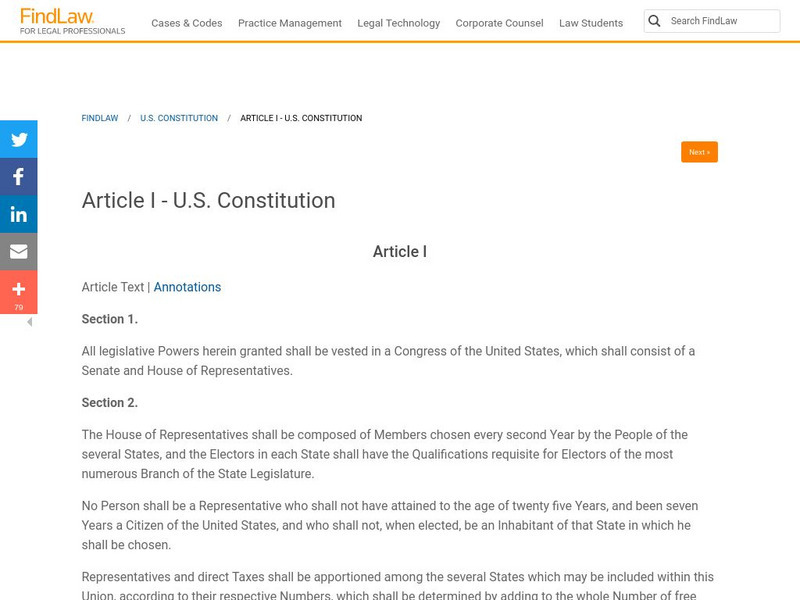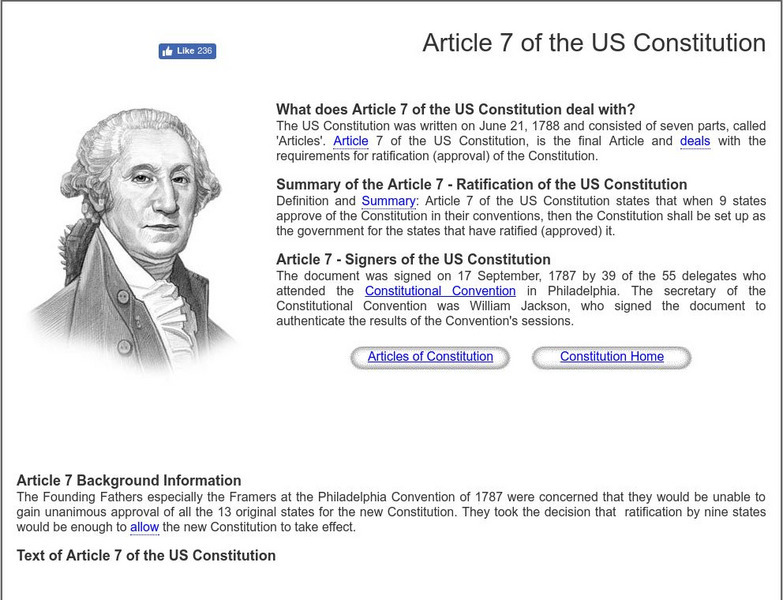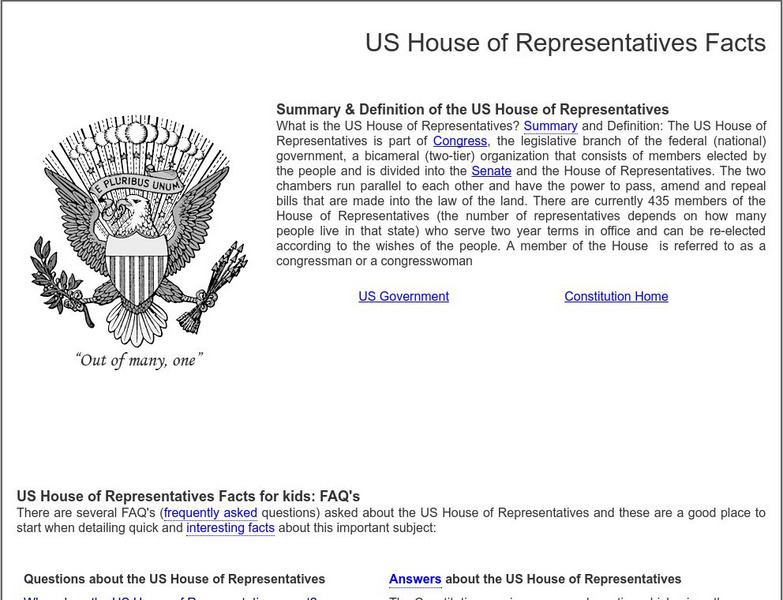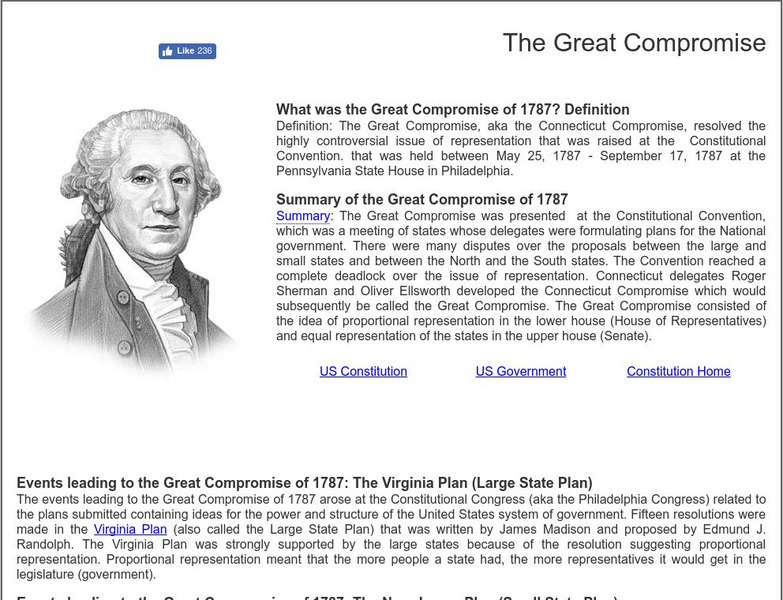Hi, what do you want to do?
Siteseen
Siteseen: Government and Constitution: Constitutional Convention
The delegates of the Constitutional Convention framed the Constitution of the United States as a basis of government to address the weaknesses of the Articles of Confederation.
The Dirksen Congressional Center
Congress Link: Lesson Plans
The Dirksen Congressional Center provides abundant lesson plans on all aspects of the US Congress and the US Constitution. All lessons contain time frames, objectives, and links to material, and are built around Bloom's taxonomy.
Thomson Reuters
Find Law: u.s. Constitution: Article I
Complete text of Article I, sections 1-10, of the U.S. Constitution, establishing the Legislative Branch of the Federal government.
US Government Publishing Office
Ben's Guide to u.s. Government: Constitution of the United States
Find background information on the Constitution of the United States of America, and learn the three basic principles upon which the Constitution was written. Additional content includes a look at the text of the Constitution, the events...
Ohio State University
Osu History Teaching Institute: Articles of Confederation vs. the u.s. Constitution
Fourth graders will be introduced to the primary documents of the Articles of Confederation and the US Constitution. They will figure out the weaknesses of the Articles of Confederation and compare them to the US Constitution. Students...
US Government Publishing Office
Ben's Guide to u.s. Government: Rights of Citizens: The Bill of Rights (Grades 6 8)
Ben's Guide is a fun way to present US laws to students grades K-12. This site presents a brief history of the Bill of Rights. Links to related sites are available.
Siteseen
Siteseen: Government and Constitution: Article 7 of the Us Constitution
Article 7 of the Constitution deals with the requirements for ratification (approval) of the Constitution. It states that ratification by nine states would be enough to allow the new Constitution to take effect.
Siteseen
Siteseen: Government and Constitution: Article 6 of the Us Constitution
Provides a summary and full text of Article 6 of the Constitution. It establishes it as the supreme law of the United States and that public officials must take an oath to support it. It also authorizes the national debt, meaning that...
Siteseen
Siteseen: Government and Constitution: Us House of Representatives Facts
Detailed facts and information provide a quick overview of how the US House of Representatives, a part of Congress, works.
Siteseen
Siteseen: Government and Constitution: Us Congress Facts
Article provides an overview and interesting facts about the United States Congress, the legislative branch of the federal government.
Siteseen
Siteseen: Government and Constitution: Preamble to the Constitution
This article contains the history, meaning, and words to the Preamble to the Constitution which encompassed the reasons why the thirteen original colonies separated from Great Britain to become an independent nation.
Siteseen
Siteseen: Government and Constitution: Virginia Plan
Learn about the Virginia Plan that was based on a national and state government system with a separation of powers consisting of legislative, executive, and judicial branches. It also contained a resolution for proportional...
Siteseen
Siteseen: Government and Constitution: Branches of Government
This article contains a useful guide to the functions of the three US Branches of Government that make, enforce, or interprets laws.
Siteseen
Siteseen: Government and Constitution: The Three Fifths Compromise
The Three-Fifths Compromise that was presented at the Constitutional Convention resolved the issue of counting slaves towards the population in regards to representation in the House of Representatives.
Siteseen
Siteseen: Government and Constitution: The Great Compromise
Covers details of the Great Compromise which was presented at the Constitutional Convention. It consisted of the idea of proportional representation in the lower house (House of Representatives) and equal representation of the states in...
Siteseen
Siteseen: Government and Constitution: Slave Trade Compromise
The Commerce and Slave Trade Compromise was reached at the Constitutional Convention by stating that Congress could not prohibit the slave trade until 1808, but that any imported slaves could be taxed.
Siteseen
Siteseen: Government and Constitution: 10th Amendment
Short, simple summary with the full text of the 10th amendment of the Bill of Rights that states that any powers that the Constitution does not give to the US government, belong to the individual states and the people.
Other
Angelo State University: Constitutional Government
An outline of the key points in a lecture that looks at the differences between the U.S. Constitution and the Texas Constitution.
Georgia Department of Education
Ga Virtual Learning: Us History: The Constitution and New Nation
US History learning module on the post revolutionary period discussing the fundamentals of writing the Constitution and a new form of government.
Cato Institute
Cato Institute: Congress, the Courts, and the Constitution [Pdf]
An analysis of the conflicting views on the fundamental role of the government of the United States, specifically on the relationship between the different branches of the federal government, and what the Cato Institute regards as their...
US Government Publishing Office
Ben's Guide to u.s. Government: Grades K 2
Here you can learn all about the U.S. Government! Find information on our nation, how our government works, your own neighborhood, and the main government symbols. Games and other activities are also included!
US Mint
United States Mint: Branches of Power
Save the federal government from Oppressor Sam, and learn about the US Constitution to restore the three branches of government.
University of Groningen
American History: Outlines: Drafting the Constitution
Essay covers from the Articles of Confederation and the problems of disunity of the new states after the Revolutionary War, internally as well as externally, to the Constitutional Convention, an attempt to address the Articles' problems....
Oswego City School District
Regents Exam Prep Center: Introduction to u.s. Government
Explore the ideas and principles of American government including its influences, foundation, and basic tenets (such as checks and balances and federalism).




















